Developer Guide
By: Team CS2103-F09-3 (Mo YunBin, Jessica Jacelyn, Koh Su En, Zheng ZiKang)
- 1. Acknowledgements
- 2. Setting up
- 3. Design
- 4. Implementation
- 5. Documentation
- Appendix A: Product Scope
- Appendix B: User Stories
- Appendix C: Use Cases
- Appendix D: Non Functional Requirements
- Appendix E: Glossary
- Appendix F: Instructions for Manual Testing
- Appendix G: Effort
1. Acknowledgements
- This project is based on the se-edu/addressbook-level3 created by the SE-EDU initiative.
- The following libraries were also used in the Mr.Agent.
2. Setting up, getting started
Refer to the guide Setting up and getting started.
3. Design
3.1. Architecture
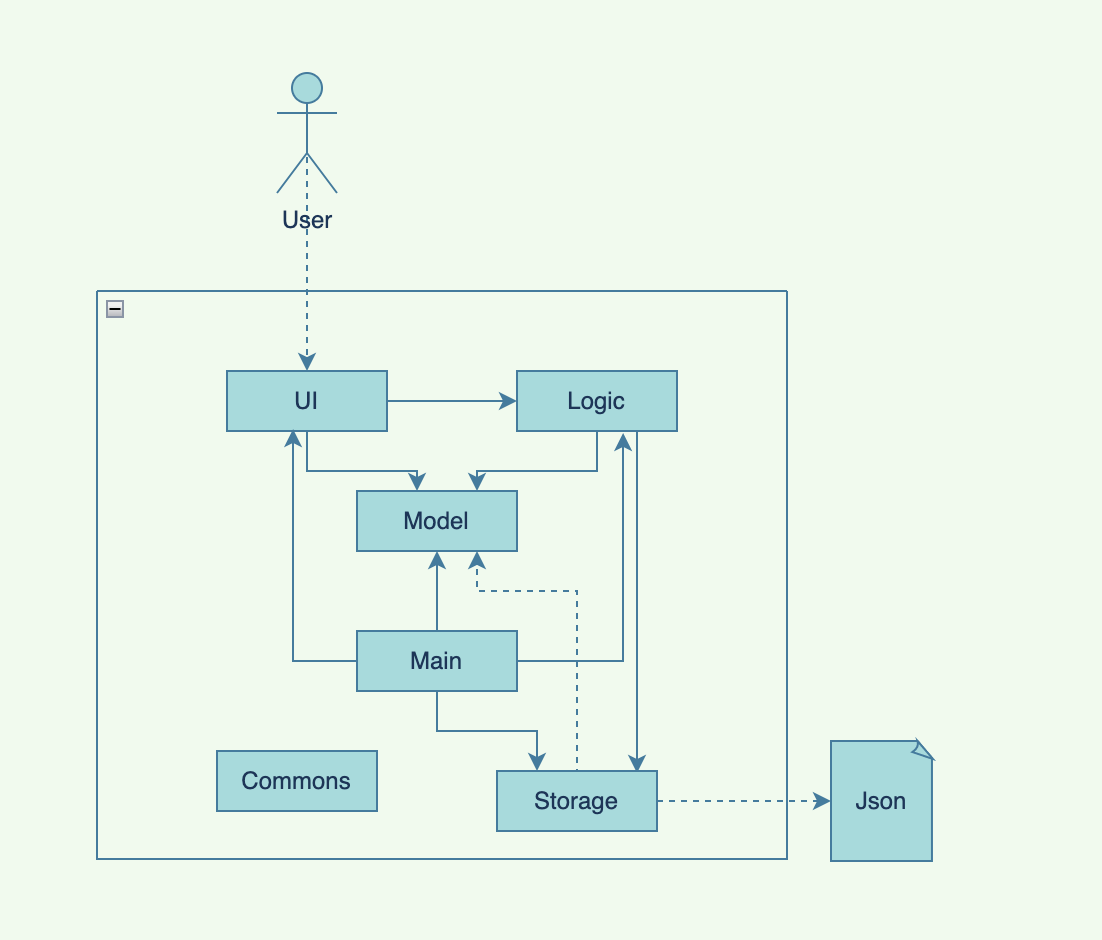
The Architecture Diagram given above explains the high-level design of the App.
Given below is a quick overview of main components and how they interact with each other.
Main components of the architecture
Main has two classes called Main and MainApp. It is responsible for,
- At app launch: Initializes the components in the correct sequence, and connects them up with each other.
- At shut down: Shuts down the components and invokes cleanup methods where necessary.
Commons represents a collection of classes used by multiple other components.
The rest of the App consists of four components.
-
UI: The UI of the App. -
Logic: The command executor. -
Model: Holds the data of the App in memory. -
Storage: Reads data from, and writes data to, the hard disk.
How the architecture components interact with each other
The Sequence Diagram below shows how the components interact with each other for the scenario where the user issues the command delete -c 1.

Each of the four main components (also shown in the diagram above),
- Defines its API in an
interfacewith the same name as the Component. - Implements its functionality using a concrete
{Component Name}Managerclass (which follows the corresponding APIinterfacementioned in the previous point).
For example, the Logic component defines its API in the Logic.java interface and implements its functionality using the LogicManager.java class which follows the Logic interface. Other components interact with a given component through its interface rather than the concrete class (reason: to prevent outside component’s being coupled to the implementation of a component), as illustrated in the (partial) class diagram below.
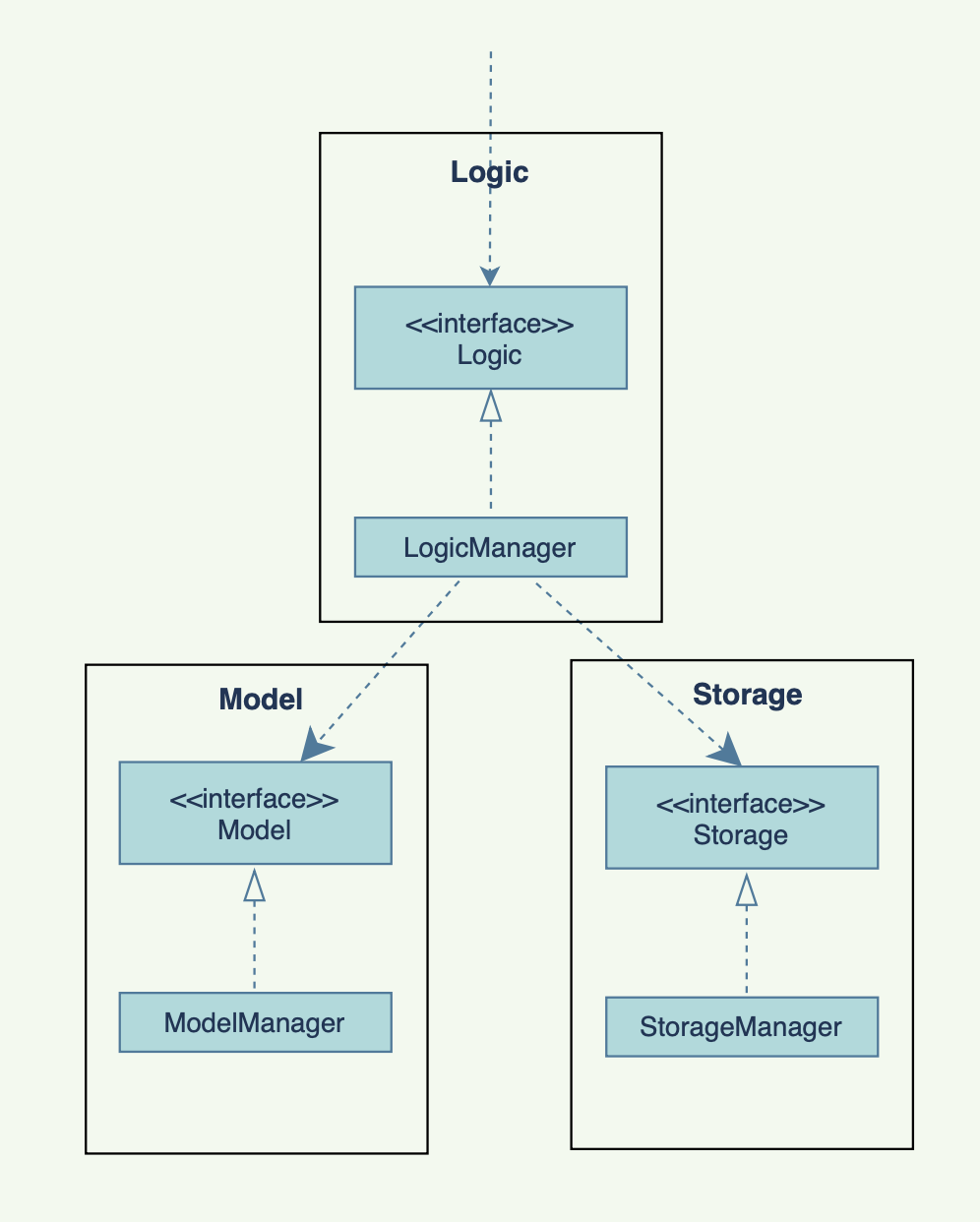
The sections below give more details of each component.
3.2. UI component
The API of this component is specified in Ui.java
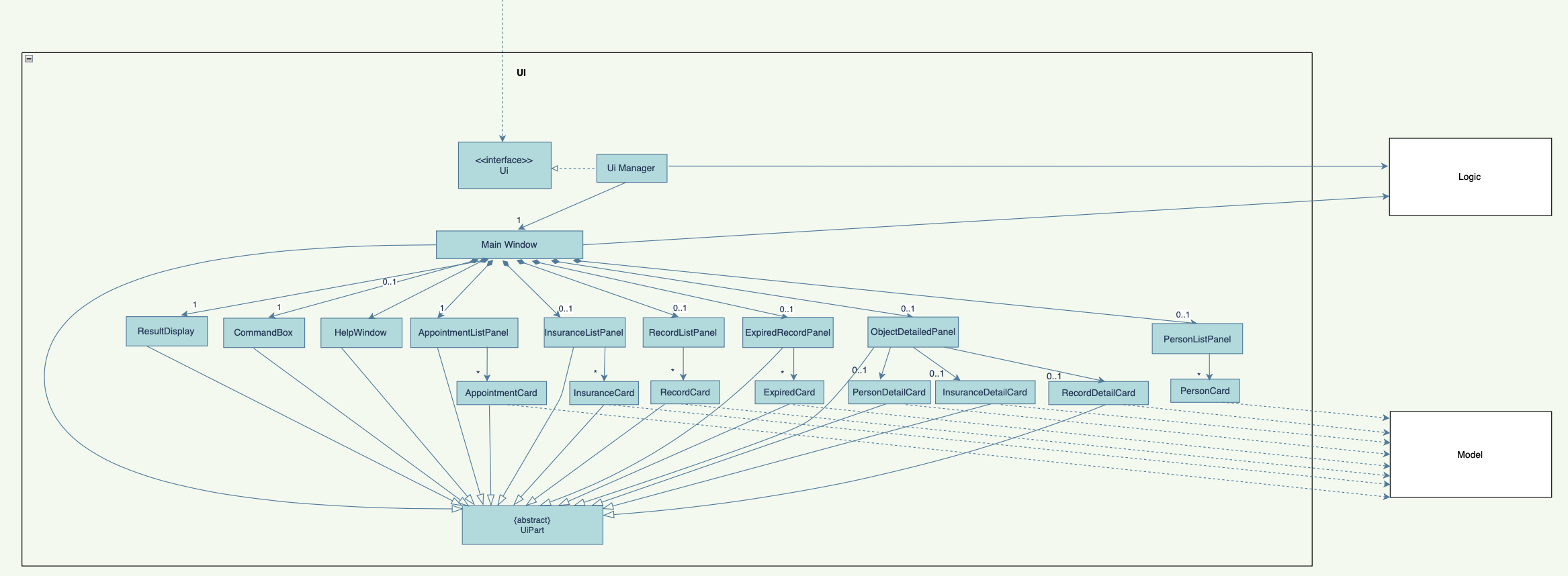
The UI consists of a MainWindow that is made up of parts e.g.CommandBox, ResultDisplay, PersonListPanel, AppointmentListPanel, InsuranceListPanel, RecordListPanel, ExpiredRecordPanel, ObejctDetailedPanel etc. All these, including the MainWindow, inherit from the abstract UiPart class which captures the commonalities between classes that represent parts of the visible GUI.
The UI component uses the JavaFx UI framework. The layout of these UI parts are defined in matching .fxml files that are in the src/main/resources/view folder. For example, the layout of the MainWindow is specified in MainWindow.fxml
The UI component,
- Executes user commands using the
Logiccomponent. - Listens for changes to
Modeldata so that the UI can be updated with the modified data. - Keeps a reference to the
Logiccomponent, because theUIrelies on theLogicto execute commands. - Depends on some classes in the
Modelcomponent, as it displaysPersonobject residing in theModel. - Does not replace the right panel -
AppointmentListPanelat any time. - Based on the user commands, left panel changes accordingly. e.g. when
list -ris entered,RecordListPanelwill replace the existing panel. - Listens for user click on
PersonListPaneland will update theObjectDetailedPanelto show respective client’s information.
3.3. Logic component
API : Logic.java
Here’s a (partial) class diagram of the Logic component:
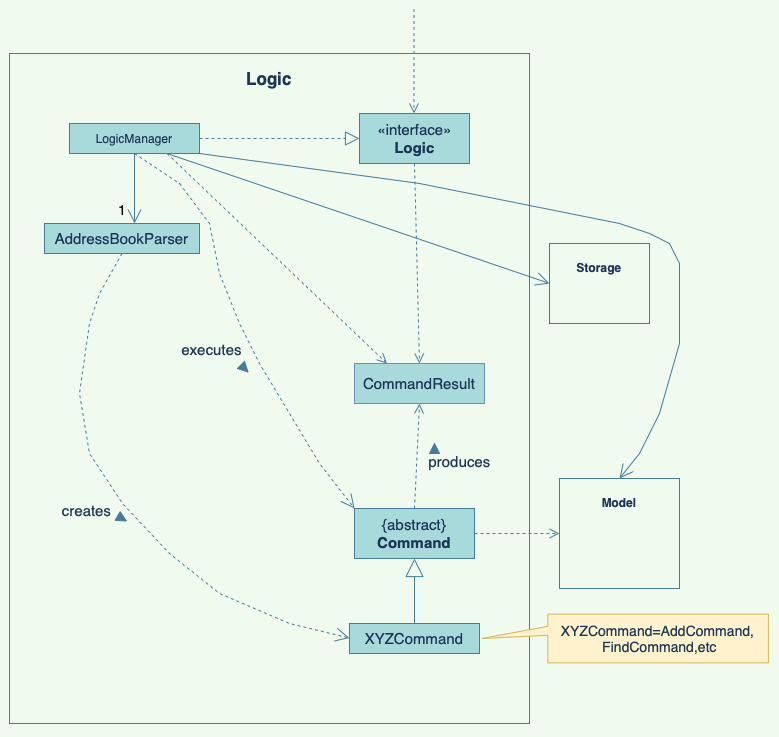
How the Logic component works:
- When
Logicis called upon to execute a command, it uses theAddressBookParserclass to parse the user command. - This results in a
Commandobject (more precisely, an object of one of its subclasses e.g.,AddCommand) which is executed by theLogicManager. - The command can communicate with the
Modelwhen it is executed (e.g. to add a client). - The result of the command execution is encapsulated as a
CommandResultobject which is returned fromLogic.
The Sequence Diagram below illustrates the interactions within the Logic component for the execute("delete -c 1") API call.
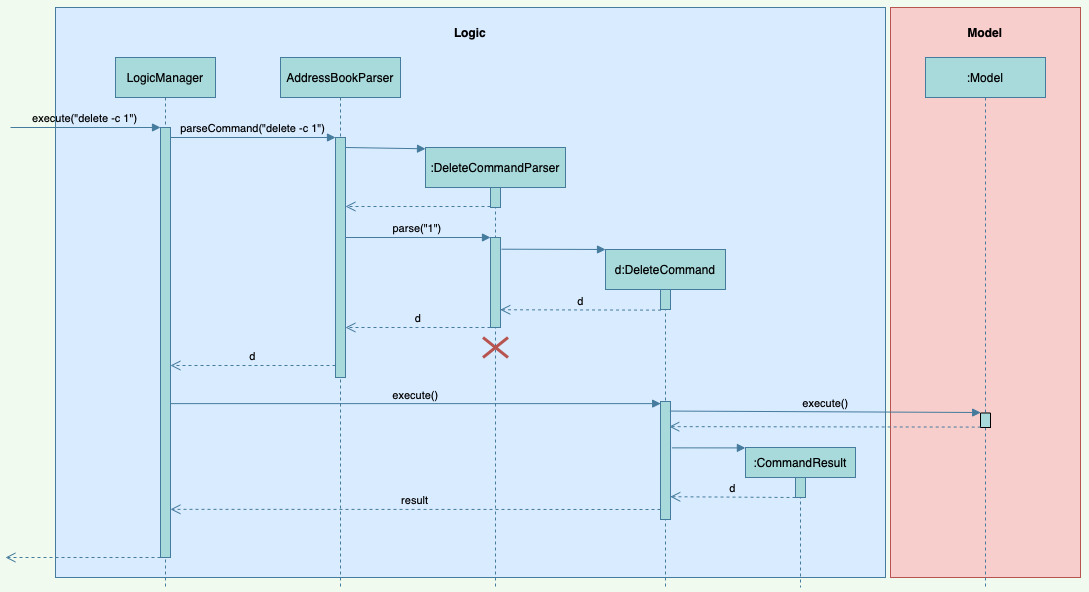
DeleteCommandParser should end at the destroy marker (X) but due to a limitation of PlantUML, the lifeline reaches the end of diagram.
Here are the other classes in Logic (omitted from the class diagram above) that are used for parsing a user command:
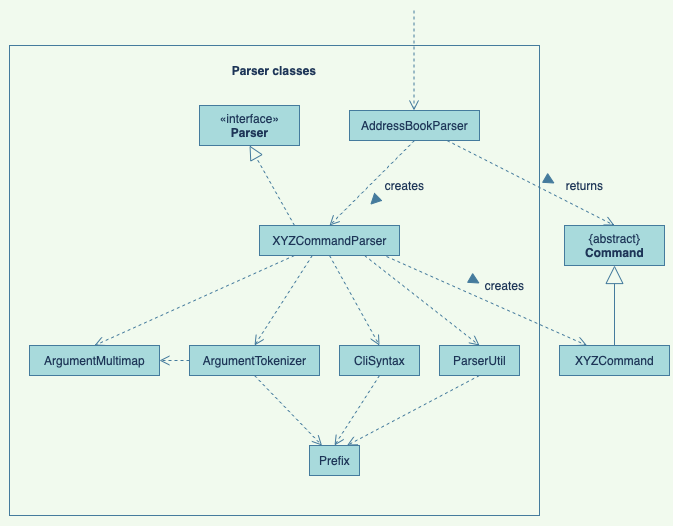
How the parsing works:
- When called upon to parse a user command, the
AddressBookParserclass creates anXYZCommandParser(XYZis a placeholder for the specific command name e.g.,AddCommandParser) which uses the other classes shown above to parse the user command and create aXYZCommandobject (e.g.,AddCommand) which theAddressBookParserreturns back as aCommandobject. - All
XYZCommandParserclasses (e.g.,AddCommandParser,DeleteCommandParser, …) inherit from theParserinterface so that they can be treated similarly where possible e.g, during testing.
3.4. Model component
API : Model.java
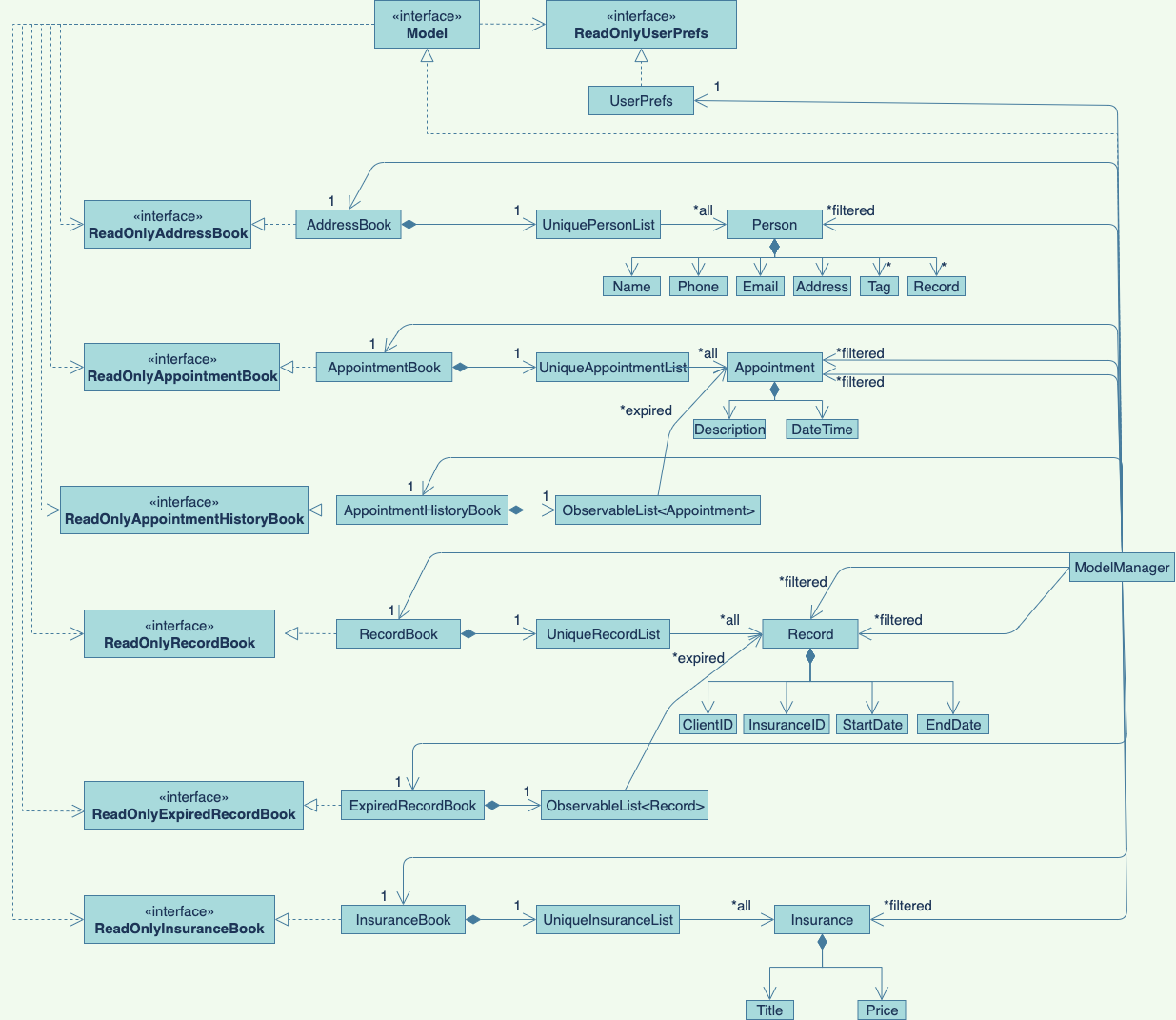
The Model component,
- stores different kinds of address book data i.e., all
Person,Appointment,Record, andInsuranceobjects (which are contained in anUniquePersonList, anUniqueAppointmentList, anUniqueRecordListand anUniqueInsuranceListrespectively). - for example, stores the currently ‘selected’
Personobjects (e.g., results of a search query) as a separate filtered list which is exposed to outsiders as an unmodifiableObservableList<Person>that can be ‘observed’ e.g. the UI can be bound to this list so that the UI automatically updates when the data in the list change. The same mechanism applies toAppointment,Record, andInsuranceobjects as well. - stores a
UserPrefobject that represents the user’s preferences. This is exposed to the outside as aReadOnlyUserPrefobjects. - does not depend on any of the other three components (as the
Modelrepresents data entities of the domain, they should make sense on their own without depending on other components)
Person object only for simplicity) is given below. It has a Tag list in the AddressBook, which Person references. This allows AddressBook to only require one Tag object per unique tag, instead of each Person needing their own Tag objects.
3.5. Storage component
API : Storage.java
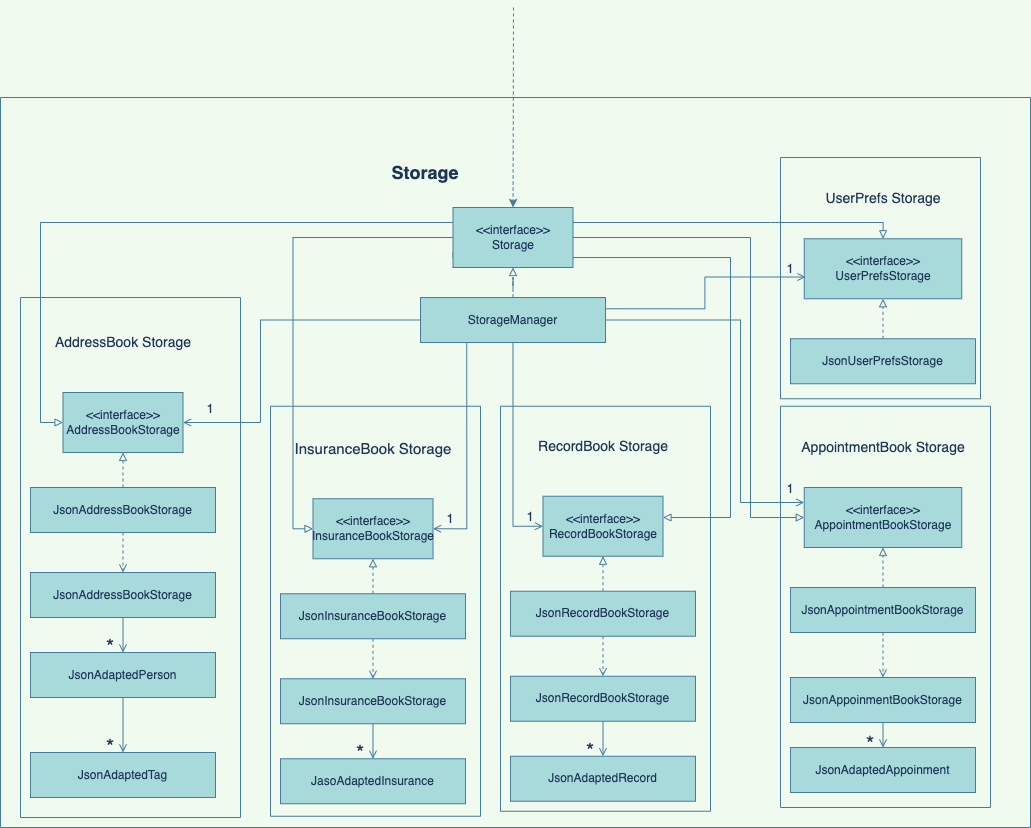
The Storage component,
- can save address book data, insurance book data, record book data, appointment book data and user preference data in json format, and read them back into corresponding objects.
- inherits from both
AddressBookStorage,InsuranceBookStorage,RecordBookStorage,AppointmentBookStorageandUserPrefStorage, which means it can be treated as either one (if only the functionality of only one is needed). - depends on some classes in the
Modelcomponent (because theStoragecomponent’s job is to save/retrieve objects that belong to theModel) - note that for history related features will only read from existing storage and will not create new json file. For example, list expired record command will search in RecordBookStorage to find expired records.
3.6. Common classes
Classes used by multiple components are in the seedu.addressbook.commons package.
4. Implementation
This section describes some noteworthy details on how certain features are implemented.
4.1. Sort Records Feature
Implementation
The Sort Records Feature is facilitated by SortRecordCommand. It extends Command with its own execution logic. It supports the following commands:
-
sort -r sa— Sort the records by start date in ascending order. -
sort -r sd— Sort the records by start date in descending order. -
sort -r ea— Sort the records by end date in ascending order. -
sort -r ed— Sort the records by end date in descending order.
These commands will be parsed by the AddressBookParser and SortReocrdCommandPasrser. ModelManger will override sortRecordBook() from Model which take in an Comparator<Record> object as input. Then ReocrdBook will sort the UniqueRecordList base on the Comparator given.
Given below is an example usage scenario and how the Sort Records Command behaves at each step.
Step 1. The user launches the application and executes sort -r sa command to sort the records by start date in ascending order.
Step 2. The LogicManager receives the input from UI#MainWindow and calls AddressBookParser#parseCommand(), causing the user input being parsed and an object of SortRecordCommand returns.
Step 3. LogicManager executes object of SortRecordCommand. SortRecordCommand will invoke ModelManager#sortRecordBook() with different Comparator base on user input.
Step 4. ModelManger will invoke RecordBook#sortRecord() with the comparator as input to sort the UniqueRecordList.
Step 5. MainWindow will update the RecordListPanel with sorted ObservableList of records.
Design considerations
Aspect: How sort records stored:
-
Alternative 1 (current choice): Saves the sorted records to RecordBook.
- Pros: Easy to implement.
- Cons: The original order of record list is not preserved.
-
Alternative 2: Creates a temporary sorted records List.
- Pros: The original order of record list is preserved.
- Cons: May have performance issues in terms of memory usage.
4.2. Sort Appointments Feature
Implementation
The Sort Appointments Feature is facilitated by SortAppointmentCommand. It extends Command with it own execution logic. It supports the following commands:
-
sort -a a— Sort the appointments by appointment time in ascending order. -
sort -a d— Sort the appointments by appointment time in descending order.
These commands will be parsed by the AddressBookParser and SortAppointmentCommandPasrser. ModelManger will override sortAppointmentBook() from Model which takes in an Comparator<Appointment> object as input. Then AppointmentBook will sort the UniqueAppointmentList base on the Comparator given.
Given below is an example usage scenario and how the Sort Appointments Command behaves at each step.
Step 1. The user launches the application and executes sort -a a command to sort the appointments by time in ascending order.
Step 2. The LogicManager receives the input from UI#MainWindow and calls AddressBookParser#parseCommand(), causing the user input being parsed and an object of SortAppointmentCommand returns.
Step 3. LogicManager executes object of SortAppointmentCommand. SortAppointmentCommand will invoke ModelManager#sortAppointmentBook() with the stated Comparator base on user input.
Step 4. ModelManger will invoke AppointmentBook#sortAppointment() with the comparator as input to sort the UniqueAppointmentList.
Step 5. MainWindow will update the AppointmentListPanel with sorted ObservableList of appointments.
Design considerations
Aspect: What is a good sorting order to use:
-
Alternative 1 (current choice): Sorts solely based on appointment date and time.
- Pros: Makes more sense for the target user as appointments are time-sensitive.
- Cons: Users have limited option of sorting order.
-
Alternative 2: Sorting options for each attribute of appointment.
- Pros: More flexible sorting options.
- Cons: Sorting by other attributes might not be useful and not even used frequently.
Moreover, design considerations for sort record command also apply here.
4.3. List history feature
Implementation
There are 2 commands in the history features, one for listing appointment history and one for expired records: The feature is facilitated by:
-
ListAppointmentHistoryCommandwhich extendsCommand, for listing appointment history. The command format islist -h. -
ListExpiredRecordsCommandwhich extendsCommand, for listing expired records. The command format islist -e.
Given below is an example usage scenario and how the list appointment history command behaves at each step.
Step 1. The user launches the application and executes list -h command to list the appointment history.
Step 2. The LogicManager receives the input from UI#MainWindow and calls AddressBookParser#parseCommand(), causing the user input being parsed and an object of ListAppointmentHistoryCommand returns.
Step 3. LogicManager executes object of ListAppointmentHistoryCommand. ListAppointmentHistoryCommand will invoke ModelManager#getAppointmentHistoryBook().
Step 4. ModelManger will invoke AppointmentHistoryBook#getAppointmentHistoryList().
Step 5. MainWindow will update the AppointmentListPanel with appointment histories.
Design considerations
Aspect: How to store the appointment history data:
-
Alternative 1 (current choice): Creates a temporary appointment history list.
- Pros: Saves storage.
- Cons: Harder to implement as separate methods has to be created to check passed appointments everytime the application is launched.
-
Alternative 2: Saves the appointment history to a separate json file.
- Pros: Easier to implement.
- Cons: Code is longer and harder to maintain.
Note: how list expired records behaves and its design considerations are the same as list appointment history
4.4. Click event feature
Implementation
The objectListPanel will be updated according to user command. It supports the following commands:
-
list -c— List all clients. -
list -i— List all insurances. -
list -r— List all records. -
list -e— List all expired records. -
list -h— List all passed appointments.
The content in detailPane will be updated with details of the object base on the click event.
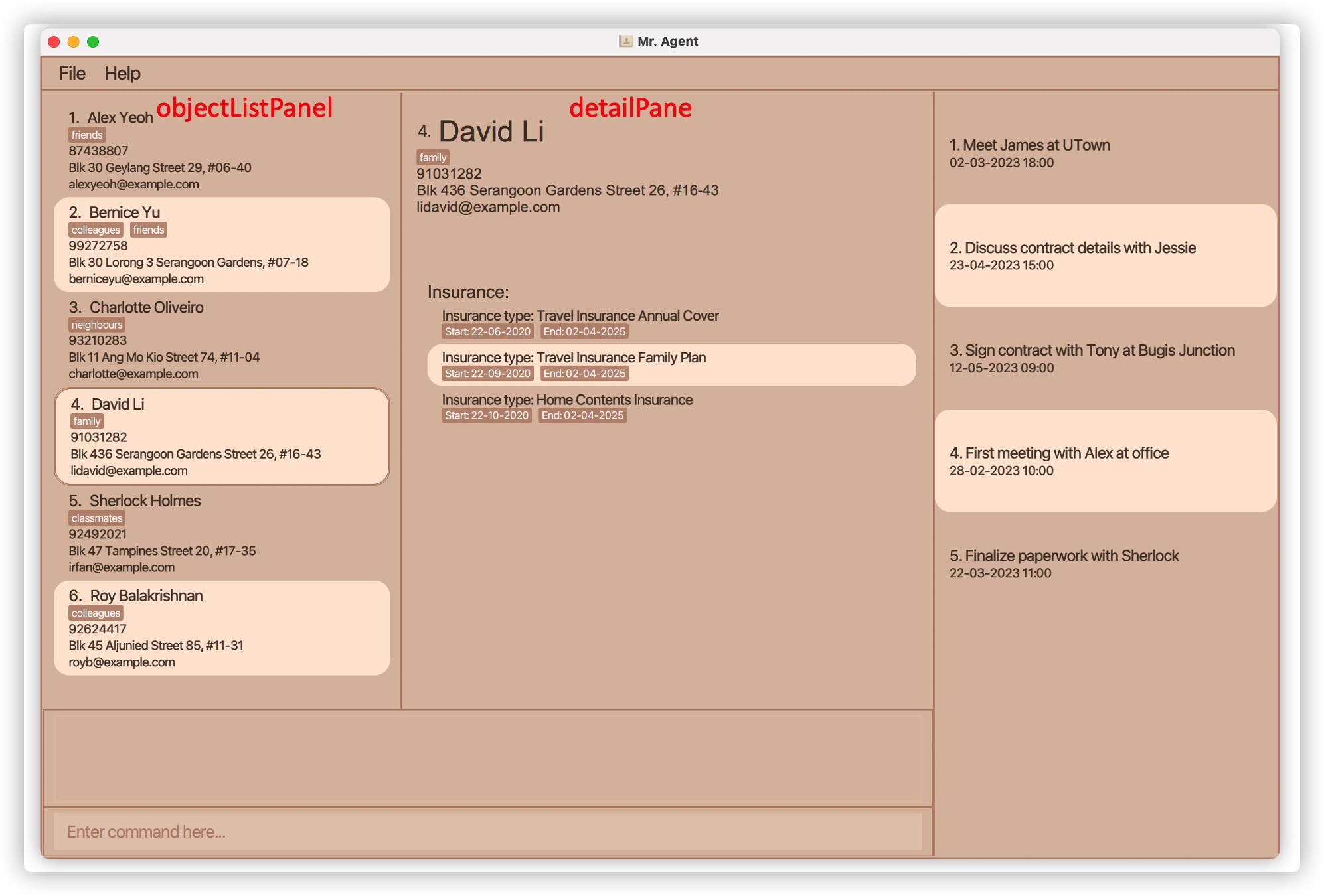
Step 1. The user launches the application and executes list -c command to list all clients.
Step 2. Then personListPanel (filled by ObservableList of client) will be added into objectListPanel as children component.
Step 3. User click on Davia Li, then PersonDetailCard (filled by the detail information of Davia Li) will be added into detailPanel as children component.
Design considerations
Aspect: How to arrange all components:
-
Alternative 1 (current choice): Update the panel base on command and click event.
- Pros:
- The UI looks more clean and clear.
- The cells of
objectListPanelonly contains important information like client name and tags.
- Cons: User needs to click on certain cell to look into details.
- Pros:
-
Alternative 2: Display everything with details(client and records information) in the
objectListPanel.- Pros: User does not need to click to look into details.
- Cons: All information are squeezed together and the list can only contain a maximum of 3-5 cells. User needs to scroll down to check other items in the list.
4.5. Add Records Feature
Implementation
The Add Records Feature will be facilitated by AddRecordCommand which implements Parser and AddCommand which extends Command.
The command format is add -r c/ClientIndex i/InsuranceIndex sd/StartDate ed/EndDate - add a record to the client at ClientIndex with insurance of InsuranceIndex valid from StartDate to EndDate
The relevant methods are:
-
AddCommandParser#parse(List<Person> personList, ObservableList<Insurance> insuranceList, String args)–> Parse the relevant detailed information -
AddCommand#execute(Model model)–> Checks for duplication , validate each information and store to library
Given below is an example usage scenario and how the AddCommand behaves at each step.
Step1. The user launches the application and executes add -r c/1 i/1 sd/22-03-2022 ed/ 22-03-2032
Step2. The LogicManager receives the input from UI#MainWindow and calls AddressBookParser#parseCommand(),
and determine that it is an Add Command.
Step3. AddCommandParser would check if the ClientIndex and InsuranceIndex exist in the library. Then it will continue to check if the StartDate is before the EndDate
Step4. Execution of Add would take place and the result will be updated in the filtered record list Model.
Important Features to take note:
- The
add recordcommand takes in theClientIndexandInsuranceIndexbut stores the Client’sNameand Insurance’sTitlein the RecordBook. - The
sd/STARTDATEentered must strictly be before thesd/ENDDATE, elseParseExceptionwill be thrown
Design considerations
Aspect: How to add record to recordBook:
-
Alternative 1 (current choice): User inputs all required information at once
- Pros:
- Faster response rate as system does not need to prompt and wait for the user to key in the information needed.
- Users, who are fast-typers, can enter information at once, increasing efficiency.
- Cons: More prone to typo errors.
- Pros:
-
Alternative 2: System prompts and user input information one at a time
- Pros: Easier for user to view their input, reducing typing errors.
- Cons: Less responsive as user needs to wait for the system to validate the information entered one at a time before prompting the user to key in the next information.
4.6. Find Appointments Feature
Implementation
The Find Appointments Feature will be facilitated by FindAppointmentCommand which extends Command with its own execution logic, the following command is supported:
- find -a KEYWORD [MORE_KEYWORDS]
This command will be parsed by the AddressBookParser and then handled by the FindAppointmentCommandParser, which then returns an executable FindAppointmentCommand if the input is valid.
Given below is an example usage scenario and how the FindAppointmentCommand is processed at each step.
Step 1. The user launches the application and executes find -a Bugis
Step 2. The LogicManager receives the input from UI#MainWindow and calls AddressBookParser#parseCommand(), and determines that it is a command related to Appointment.
Step 3. The inputs are directed to AddressBookParser#parseAppointmentCommand where the FindAppointmentCommandParser is invoked.
Step 4. A FindAppointmentCommand object is returned to LogicManager, it then gets executed where ModelManager will update the filteredAppointmentList using the keyword.
Step 5. MainWindow will update the AppointmentListPanel to show the appointments whose description contains the keyword.
Design considerations
Aspect: How to filter the appointment list:
-
Alternative 1 (current choice): Finds appointments by keyword
- Pros: The filtered result tends to be more relevant.
- Cons: User must enter the keyword correctly and completely to locate the desired appointments (partial words would not be matched).
-
Alternative 2: Finds appointment by partial/complete keyword or date and time
- Pros: More friendly to use when user cannot remember the full search term to use.
- Cons:
- Filtering by date and time does not add much value since
sort -acommand already exists. - User might get less relevant filtered result.
- Filtering by date and time does not add much value since
5. Documentation, logging, testing, configuration, dev-ops
Appendix: Requirements
Product scope
Target user profile:
- has a need to manage a significant number of clients
- has a need to manage and schedule numerous appointments
- prefer desktop apps over other types
- prefers typing to mouse interactions
- is reasonably comfortable using CLI apps
Value proposition: manage clients, insurances, records and appointments faster than a typical mouse/GUI driven app
User stories
Priorities: High (must have) - * * *, Medium (nice to have) - * *, Low (unlikely to have) - *
| Priority | As a … | I want to … | So that I can… |
|---|---|---|---|
* * * |
new user | see usage instructions | refer to instructions when I forget how to use the App |
* * * |
insurance agent | add a new client | manage clients in the application |
* * * |
insurance agent | delete a client | remove entries that I no longer need |
* * * |
insurance agent | find a client by name | locate details of clients without having to go through the entire list |
* * * |
insurance agent | list all clients | view clients that are in my contact |
* * * |
insurance agent | add an insurance | manage all insurances in the apllication |
* * * |
insurance agent | edit an insurance | make changes to insurance saved in the application |
* * * |
insurance agent | list all insurances | view all that I have stored in the application |
* * * |
insurance agent | delete an insurance | remove entries that I no longer need |
* * * |
insurance agent | find insurances by title | locate insurances without having to go through the entire list |
* * * |
insurance agent | add a record to client | keep a record of the insurances that the client have |
* * * |
insurance agent | delete a record | remove entries that I no longer need |
* * * |
insurance agent | edit a record | make changes to record saved in the application |
* * * |
insurance agent | list all records | view records that are I have with my clients |
* |
insurance agent want to check records | sort record by start/end date | locate almost expired/newest records easily |
* * * |
insurance agent frequently having appointments | view all appointments | be reminded of all the meetings I have with my clients |
* * * |
insurance agent frequently having appointments | add new appointments | note down any future meetings I have with my client |
* * * |
insurance agent frequently having appointments | delete an appointment | get rid of any canceled/completed appointments to avoid confusion |
* * * |
insurance agent frequently having appointments | edit an appointment | amend appointment details to suit clients’ needs |
* * * |
insurance agent frequently having appointments | find an appointment | quickly locate a related appointment |
* * * |
insurance agent frequently having appointments | sort appointments | prioritize more urgent appointments |
* * * |
insurance agent frequently having appointments | clear all appointments | have cleaner view of appointments after a long time |
* * * |
insurance agent | view passed appointments | know account my meetups with my clients |
* * * |
insurance agent | view expired records | refer to passed records in case clients want to know/renew insurance |
Use cases
(For all use cases below, the System is the Mr Agent and the Actor is the user, unless specified otherwise. The other functionalities, including Insurance, Record, Appointment follow similar flows as client, therefore, the related use cases are omitted here.)
Use case: Add a client
MSS
- User enters command and arguments to add new client.
- Mr Agent shows success message for adding client.
Extensions
-
2a. The argument(s) are incomplete.
-
2a1. Mr Agent shows an error message.
Use case resumes at step 1.
-
Use case: Edit a client
MSS
- User requests to list clients.
- Mr Agent shows a list of clients.
- User requests to edit a specific client by index in the list and enters requested details.
-
Mr Agent updates the client.
Use case ends.
Extensions
-
2a. The list is empty.
Use case ends.
-
3a. The given index is invalid.
-
3a1. Mr Agent shows an error message.
Use case resumes at step 2.
-
-
3b. Mr Agent detects an error in the entered data.
-
3a1. Mr Agent shows an error message.
Use case resumes at step 3.
-
Use case: List a client
MSS
- User requests to list clients
-
Mr Agent shows a list of clients
Use case ends.
Extensions
-
2a. The list is empty.
Use case ends.
Use case: Delete a client
MSS
- User requests to list clients
- Mr Agent shows a list of clients
- User requests to delete a specific client by index in the list
-
Mr Agent deletes the client
Use case ends.
Extensions
-
2a. The list is empty.
Use case ends.
-
3a. The given index is invalid.
-
3a1. Mr Agent shows an error message.
Use case resumes at step 2.
-
Use case: Sort appointments
MSS
- User enters command and arguments to sort appointments ascendingly.
- Mr Agent shows success message for sorting appointments.
Extensions
-
1a. The argument(s) are incomplete.
-
1a1. Mr Agent shows an error message and correct command usage.
Use case resumes at step 1.
-
Non-Functional Requirements
- Should work on any mainstream OS as long as it has Java
11or above installed. - Should be able to hold up to 1000 clients without a noticeable sluggishness in performance for typical usage.
- A user with above average typing speed for regular English text (i.e. not code, not system admin commands) should be able to accomplish most of the tasks faster using commands than using the mouse.
- No network connection needed.
- The source code should be open source.
- The user interface should be intuitive enough for users who are not IT-savvy.
Glossary
- Appointment: To-dos created by user, with description, data and time specified.
- Appointment History: Appointments that have passed (before the current time).
- Client: Contacts that needs to be managed by user.
- Expired Record: Records that have passed its end date.
- Insurance category: Types of insurance, e.g. health, financial, life.
- Insurance code: Unique IDs attached to each insurance.
- Mainstream OS: Windows, Linux, Unix, OS-X.
- Record: Record of insurance that is bought by a client, i.e. when a client purchase an insurance, a new record will be created and saved in the database with the client and insurance’s IDs. Each record is unique.
Instructions for manual testing
Given below are instructions to test the app manually.
Launch and shutdown
-
Initial launch
-
Download the jar file and copy into an empty folder
-
Double-click the jar file Expected: Shows the GUI with a set of sample contacts. The window size may not be optimum.
-
-
Saving window preferences
-
Resize the window to an optimum size. Move the window to a different location. Close the window.
-
Re-launch the app by double-clicking the jar file.
Expected: The most recent window size and location is retained.
-
Adding a client
-
Adding a client
-
Test case:
add -c n/James Ho p/12345678 e/jamesho@example.com a/nus-pgp
Expected: Client named James Ho with phone number 2345678, email account at jamesho@example.com and address of nus-pgp is addded to the list. Details of the added client shown in the status message and on the detailPane -
Test case:
add -c p/12345678 e/jamesho@example.com a/nus-pgp
Expected: No client is added. Error details shown in the status message. -
Other incorrect delete commands to try:
add -c,add -c n/
Expected: Similar to previous.
-
Deleting a client
-
Deleting a client while all clients are being shown
-
Prerequisites: List all clients using the
list -ccommand. Multiple clients in the list. -
Test case:
delete -c 1
Expected: First client is deleted from the list. Details of the deleted contact shown in the status message. Timestamp in the status bar is updated. -
Test case:
delete -c 0
Expected: No client is deleted. Error details shown in the status message. Status bar remains the same. -
Other incorrect delete commands to try:
delete -c,delete -c x,...(where x is larger than the list size)
Expected: Similar to previous.
-
Editing a client
-
Editing a client while all clients are being shown
-
Prerequisites: List all clients using the
list -ccommand. Multiple clients in the list. -
Test case:
edit -c 6 n/James Lee e/jameslee@example.com
Expected: Sixth client’s details is edited, name will be changeed to James Lee, email address changed to jameslee@example.com. Details of the edited client shown in the status message and on the detailPane -
Test case:
edit -c p/12345678 e/jamesho@example.com a/nus-pgp
Expected: No client is edited. Error details shown in the status message. -
Other incorrect delete commands to try:
edit -c 0,edit -c,edit -c x,...(where x is larger than the list size)
Expected: Similar to previous.
-
Finding a client
-
Finding a client
-
Test case:
find -c James Yu
Expected: ClientBernince YuandJames Leewill be shown on the objectListPanel and number of clients found shown in status message -
Test case:
find -c
Expected: No client found. Error details shown in the status message.
-
Sorting records
-
Sorting records while all records are being shown
-
Prerequisites: List all records using the
list -rcommand. Multiple records in the list. -
Test case:
sort -r sa
Expected: Records are being sorted in ascending order by start date. Sorted records are shown in the objectListPanel and details of sorting is shown in status message. -
Other correct sort commands to try:
sort -r ea,sort -r sd,sort -r ed
Expected: Similar to previous. -
Test case:
sort -r
Expected: No records sorted. Error details shown in the status message. -
Other incorrect sort commands to try:
sort -r,sort -r ta
Expected: Similar to previous.
-
Saving data
-
Dealing with missing/corrupted data files
-
Test case: delete addressbook.json and launch the program
Expected: Sample data of clients will be populated. Details of the populated client shown in the objectListPanel -
Other test case for missing data files : delete appointmentbook.json/insurancebook.json/recordbook.json and launch the program
Expected: Sample data of clients will be populated. Details of the populated client shown in the objectListPanel -
Test case: corrupt addressbook.json by removing the name field from the client data
Expected: Empty addressbook will be created. -
Other test case for corrupted data files: remove the
descriptionfield from the appointmentbook.json / remove thetitlefield from the insurancebook.json / remove thestartDatefield from the recordbook.json
Expected: Similar to previous.
-
Effort
-
Difficulty level: This project enhanced the current AB3 implementation to make it a more complicated application that includes more data entities including
Insurance,Record, andAppointment. By taking into account our targeted user group’s requirements, attributes of the entities were carefully selected so that they work together to provide beneficial functionalities for insurance agents. -
Challenge faced:
- The GUI needed to be rearranged to fit our data display needs, problems including responsiveness of the GUI and the appropriate types of JAVAFX components to be used were our top concerns.
- To reduce coupling of different entities, we had to change/add internal structures and mechanisms such as parser to meet our needs.
- Achievements: Most of the added functionalities have strong cohesion and low coupling, making them extensible for future modifications.
-
Regarding reuse: Added entities follow a similar structure as that used by
Personin AB3, with modifications, which saved our efforts in maintaining consistency with the original AB3 as well as in creating the whole application structure.